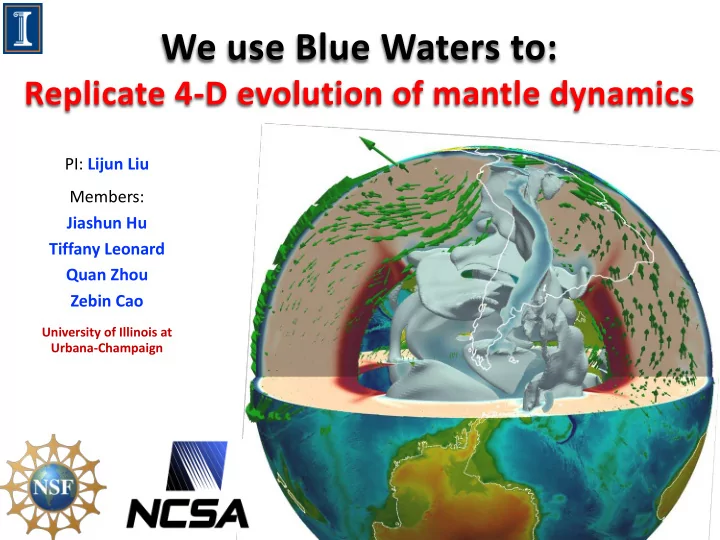

We use Blue Waters to: Replicate 4-D evolution of mantle dynamics PI: Lijun Liu Members: Jiashun Hu Tiffany Leonard Quan Zhou Zebin Cao University of Illinois at Urbana-Champaign
Why Blue Waters? • Earth’s mantle is a complex system whose dynamics requires quantification of many observations (both surface and internal) simultaneously. Traditional mantle models are often simplified and thus incapable to explain various geological processes. • Thus, we advocate data-oriented numerical modeling: – Sophisticated numerical codes. – Efficient computational platform. – Blue Waters represents the best choice for expanding current modeling capability.
With Blue Waters • We extend the scalability of the community mantle convection code CitcomS. 1. Increasing total MPI cores by 10 fold, to ~10,000
Leading to increased model resolution & larger model domain. (Manea et al., Geology , 2012) (Hu et al., EPP , 2018)
With Blue Waters • We extend the scalability of the community mantle convection code CitcomS. 1. Increasing total MPI cores by 10 fold, to ~10,000 2. Resolving fine mantle features like slabs and plumes within whole mantle-scale models.
Well-reproduced South American slab Predicted S. American slab geometry that matches multiple observational constraints: Steep & flat slab segments • Geometry of seismicity distribution • Slab tears causing abnormal volcanism • (Hu et al., EPSL , 2016)
With Blue Waters • We extend the scalability of the community mantle convection code CitcomS. 1. Increasing total MPI cores by 10 fold, to ~10,000 2. Resolving fine mantle features like slabs and plumes within whole mantle-scale models. 3. Developed realistic regional convection models for South America and North America.
Better representation of South American subduction (1300 km) 8 (Hu et al., EPSL, 2016)
Constrained mantle flow Allowing for the quantification of mantle deformation. (Hu et al., EPSL , 2017) Depth (km) 0 500 1000 New insight 1500 on evolution of continent Continental lithosphere has a layered density and is less stable than previously thought. (Hu et al., Nature Geoscience , 2018)
Better resolution of mantle upwelling below the western United States (Zhou et al., EPSL , 2018)
Puzzling Yellowstone Volcanic Province CRFB: Columbia River flood basalt 1000 km YS: Yellowstone hotspot track NB: Newberry hotspot track D C A B Debated origin: Vertically rising • mantle plume Shallow subduction • processes
18 Ma 14 Ma C B W A Y D C DW1 DW1 Y S P l u m e 660 km Heat below YS predominantly DW2 DW2 came from the 12 Ma Pacific mantle. 8 M a DW1 D W 1 The mantle plume plays a minor role in DW2 DW2 generating YS 4 Ma 0 M a volcanism. DW1 DW1 DW1 DW1 Plume DW2 DW2 (Zhou et al., Nature Geoscience , 2018) 12 ∆ T/ºC velocity 5cm/yr Movement of hot anomaly --400 --300 --200 --100 - 0 - 100
Eastward intrusion of hot Pacific mantle forms YS CRB (Zhou et al., Nature Geoscience , 2018) 13
Model validation by seismic anisotropy - Rock fabric formed by mantle deformation Observed (dark) and modeled (green) seismic anisotropy due to the subduction history discussed above. (Zhou et al., EPSL , 2018)
Help to resolve the enigmatic topographic evolution of western U.S. 15 (Zhou & Liu, EPSL , 2019)
With Blue Waters • We extend the scalability of the community mantle convection code CitcomS. 1. Increasing total MPI cores by 10 fold, to ~10,000 2. Resolving fine mantle features like slabs and plumes within whole mantle-scale models. 3. Developed realistic regional convection models for North America and South America. 4. Developing a new-generation of high-resolution global-scale subduction and convection models.
High-resolution global-scale models
Resulting publications Liu, L. (2015), Rev. Geophysics , 53. • Liu, L. & J. Zhang (2015), Earth & Planet. Sci. Lett ., 450, 40-51. • Liu, L. & Q, Zhou (2015), Geophys. Res. Lett ., 42. • Heller, P. & L. Liu (2016), Geol. Soc. Am. Bull ., doi:10.1130/B31431.1. • • Hu, J., et al. (2016), Earth & Planet. Sci. Lett ., 438, 1-13. Leonard, T. & L. Liu, Geophys. Res. Lett ., 43, doi:10.1002/2015GL067131. • • Hu, J. & L. Liu (2016), Earth & Planet. Sci. Lett ., 450, 40-51. Liu, L. & D. Hasterok (2016), Science , 353, 1515-1519. • • Chen, L. et al. (2017), Nature Comm ., 8, doi:10.1038/ncomms15992. Hu, J. et al. (2017), Earth & Planet. Sci. Lett ., 470, 13-24. • • Kalstrom, K. et al. (2017), Desert Symp ., 145-149. Zhou, Q. & L. Liu (2017), Geochem. Geoph. Geosys., Geosys ., doi: 10.1002/2017GC007116 • • Zhou, Q. et al. (2018), Nature Geosci ., doi: 10.1038/s41561-017-0035-y. Sun, W. et al. (2018), Solid Earth Sci. , doi: 10.1016/j.sesci.2017.12.003. • • Hu, J. et al. (2018), Nature Geosci ., doi: 10.1038/s41561-018-0064-1. Hu, J. et al. (2018), Earth Planet. Phys., 2(3), 189-207. • • Zhou, Q., et al. (2018), Earth & Planet. Sci. Lett ., 500, 156-167. Zhou, Q. & L. Liu (2019), Earth & Planet. Sci. Lett ., 514, 1-12. • • Chang, C. & L. Liu (2019), J. Geophys. Res ., 124, doi:org/10.1029/2018JF004905.
Media exposure & outreach Science Magazine Nature Geoscience Science News Scientific American Yahoo News Billings Gazette Newsweek Yellowstone Insider Science Daily Daily Mail Science Node Physics Today UPI News, Cosmos Science Bull. My Science NSF, PhysOrg NCSA/UIUC NSF U. of I. news Daily Illini etc.
Recommend
More recommend